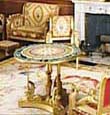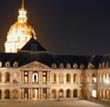| |
| |
THIS MONTH'S OBJECT
The furniture in the Salon doré at the Château de Malmaison
The reception salon at Malmaison, the Salon de compagnie, was not always as it appears today. It was transformed several times, the first taking place during the First Empire... The furniture currently in the Salon de compagnie at Malmaison comes from the palace at Saint-Cloud and was commissioned from the Jacob brothers for the empress's salon in 1802.
© RMN

|
|
|
| |
A NEW ASSOCIATION FOR THE RESTORATION OF EMPIRE FURNITURE
An Association for the restoration of the Napoleonic furnishings has just been created. Their aim is to launch a campaign to raise money for the restoration of the decorative ensembles and furniture of the Napoleonic period. Its first mission is the restoration of the Salon Doré at the Château de Malmaison. The furniture is currently in a parlous state and requires immediate restoration. © DR
For further information, click here.

|
|
|
| |
SON ET LUMIERE in the DÔME DES INVALIDES
For the 2nd Nuit Musées (Museums at night) on 20 May in Paris, the Musée de l'Armée is offering visitors a spectacular sound and light show centred on the Eglise du Dôme at the Hôtel des Invalides, each of the four chapels is to have its own acoustic environment. The event is organised by the scenographer Michel Albertini and lighting specialist Philippe Collet.
© Musée de l'Armée
For further details, click here.

|
|
|
| |
200 YEARS AGO
On 24 May, 1806, a treaty was signed in Paris which created the Kingdom of Holland. Schimmelpenninck, the Raadspensionaris, was dismissed and Louis, Napoleon's brother, installed as king.
After Revolutionary struggles of its own, led by Rutger-Jan Schimmelpenninck, Holland became a "République soeur" (sister republic) of France called the Batavian Republic. This relationship was enshrined in the treaty of The Hague (16 May, 1795), although France was de facto an occupying power. The two countries were to be linked in a defensive alliance and Holland was to cede to France Dutch Flanders, Maastricht and Venlo; 25,000 French troops were stationed there, at Dutch expense. The subsequent revolutionary period in Holland was agitated. The breakdown of relations with Britain led to the loss of Dutch colonies to Britain. In 1797, a part of the Dutch fleet was destroyed by the British at Camperduin. In 1798, the country underwent two coups d'etat, and in 1799 an Anglo-Russian force invaded, later to be driven out by Dutch patriots. In 1801, Napoleon attempted to stabilise Holland by giving it a new constitution. Political opposition to this was firmly suppressed by French general Augereau. Whilst, the Batavian Republic benefited from the return of its colonies with the Peace of Amiens (1802), these colonies were threatened again with the rekindling of Franco-British hostilities in 1803. In 1805, Napoleon negotiated with Schimmelpenninck to introduce an administration headed by a single person and Schimmelpenninck was appointed Raadspensionaris (a grand pensionary). But Franco-Dutch relations were deteriorating, and Schimmelpenninck was beginning to display a worryingly pro-British attitude. Despairing of ever finding the perfect Dutch candidate as head of state, Napoleon cut the Gordian knot on 24 May, 1806, making the Batavian Republic into the Kingdom of Holland and appointing his brother, Prince Louis (article 2), king; at that time Louis was general in chief in the Armies of the North (the Armées du Nord).
Click here for the treaty in English and German.
150 YEARS AGO
22 May, 1856, death of the historian and writer, Augustin Thierry (1795-1856).
Thierry was a pupil of the École Normale supérieure, becoming initially Professeur d'Humanités before becoming, from 1814 to 1817, private secretary (as he put it, adopted son) of the mystic political philosopher Henri de Saint-Simon. He then turned his attention to history, publishing in 1825 his popular (though erratic) work Histoire de la conquête de l'Angleterre par les Normands (History of the conquest of England by the Normans). In 1840, he published his other well-known work of history, Récits des temps mérovingiens, in which he developed his theory that there were two major events in French history, the 5th century when the Francs subjugated the Gauls, and 1789 when the Gauls got their revenge. For Thierry, the history of France should be that of the race (the plebeian Gauls) and not that of the Francs (the rulers).
For a detailed article in French on Augustin Thierry and his history, click here.
But also:
Music: On 25 May, 1856, at the age of 53, Hector Berlioz wrote: «If you asked me which of my works was my favourite, I would reply: My opinion is that of the majority of musicians, I prefer the adagio (the love scene) from Roméo et Juliette. One day, in Hanover, at the end of this piece, I felt something tugging me back. I turned round to see the players nearest to the podium kissing the tails of my jacket. But I take care to play this adagio only in certain concert halls and to specific audiences.»
(Extract from Berlioz's Mémoires, Post-Scriptum dated 25 May, 1856)
Berlioz described Roméo and Juliette as a choral symphony. The full title is ‘Dramatic symphony with chorus, vocal solos, and a prologue in choral recitative, composed after Shakespeare's tragedy'. He was very emphatic that it should not be considered an opera. It was first performed at the Paris Conservatoire (originally on the Rue du Faubourg-Poissonière) under Berlioz's direction on 24 November, 1839, with the entire intelligentsia of Paris in the audience (including Richard Wagner). However, had it not been for a donation made by Paganini it might never have seen the light of day. In fact, at a concert on 16 December 1838, that included both the Symphonie Fantastique and Harold en Italie, the celebrated violinist knelt publicly before Berlioz, hailing him as Beethoven's heir, and soon after made the gift of 20,000 francs which enabled Berlioz to pay off his debts and to write Roméo et Juliette.
For a series of anecdotes, told by Berlioz himself, about the problems he encountered finding recognition, click here.
Wishing you an excellent, Napoleonic, week.
Peter Hicks
Historian and Web editor
THE NAPOLEON.ORG BULLETIN, No 372, 19 - 25 May, 2006
Interested in the work of the Fondation Napoléon? Why not participate, either generally or in a specific project, by making a donation.
© this Napoleon.org weekly bulletin is published by the Fondation Napoléon. Reproduction or all or part of this bulletin is forbidden, without prior agreement of the Fondation Napoléon.

|
|
|
|
|
|
|
|
|
|
|
|
THIS WEEK in the MAGAZINE
WHAT'S ON
Talks:
John A. Davis, Naples, Napoleon and Europe, Naples, Italy
Commemorations:
- Wreath laying ceremony, Rivoli Veronese, Italy
- Plancenoit 2006: 8th Napoleonic Bivouac, Plancenoit, Belgium
- Pultusk 2006, Pultusk, Poland
- Jena 1806-2006 - Rendezvous in Thuringia The "Journées de Thuringe 2006" and the bicentenary of the Battle of Jena/Auerstädt; Jena, Germany
Exhibitions:
- Napoleon on the Nile: Soldiers, Artists, and the Rediscovery of Egypt, New York, USA
- Géricault, a world of madness, Lyons, France
- Il tempo dell'Imperatore: gli orologi restaurati delle residenze di Napoleoni all'Elba, Elba, Italy
- Treasures of the Fondation, Mexico 2006, Monterrey, Mexico
- Napoléon an intimate portrait, Tallahassee, Florida, USA
- "Battle in a sittingroom." The Austerlitz wallpaper, Museo Napoleonico, Rome, Italy
- "Beauty celebrating power": Vincenzo Monti in the Napoleonic period, Milan, Italy
- Louis Napoleon: at the court of the first King of Holland, 1806-1810, Apeldoorn, Netherlands
Entertainments:
Thursdays at the Museum of Florida History, Tallahassee, Florida, USA
Got a problem with the letter? Try the home page: http://www.napoleon.org
<<
|
|



